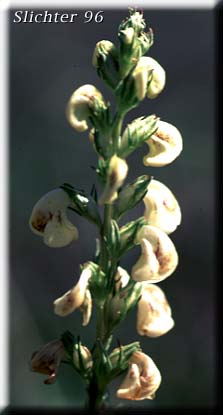 Coiled-beak lousewort as seen
from west of Sunrise, Mount Rainier National Park, August 23, 1996.
Coiled-beak lousewort as seen
from west of Sunrise, Mount Rainier National Park, August 23, 1996.
Coiled-beak lousewort is a perennial wildflower with one to several erect, glabrous stems rising from 15-40 cm high. The pinnatifid basal leaves are 5-15 cm long with 10-15 pairs of linear, toothed segments. The stem leaves are smaller and reduced in size upwards on the stems.
The inflorescence is a loosely flowered spike, about 8-20 cm long with deeply parted bracts (the divisions linear in shape) subtending each flower. The calyx is 8-9 mm long, with a cleft on the front which is about two-thirds its length and the lateral calyx-lobes about 3 mm long. The corolla is yellowish-white and is shaped somewhat like a flamingo's head. The corolla is 18-22 mm long with the wide lateral lobes of the lower lip turned upwards, enfolding the upper lip. The upper lip gradually narrows to the long, inrolled beak.
Coiled-beak lousewort may be found in open, fairly moist coniferous woods from the foothills to fairly high altitudes in the mountains.
Coiled-beak lousewort may be found from southeastern British Columbia south to the Cascade Mts. and northeastern Oregon, central Idaho and western Wyoming. It is found eastward to the Rocky Mts. of Alberta and western Montana. It may also be found in northern California.